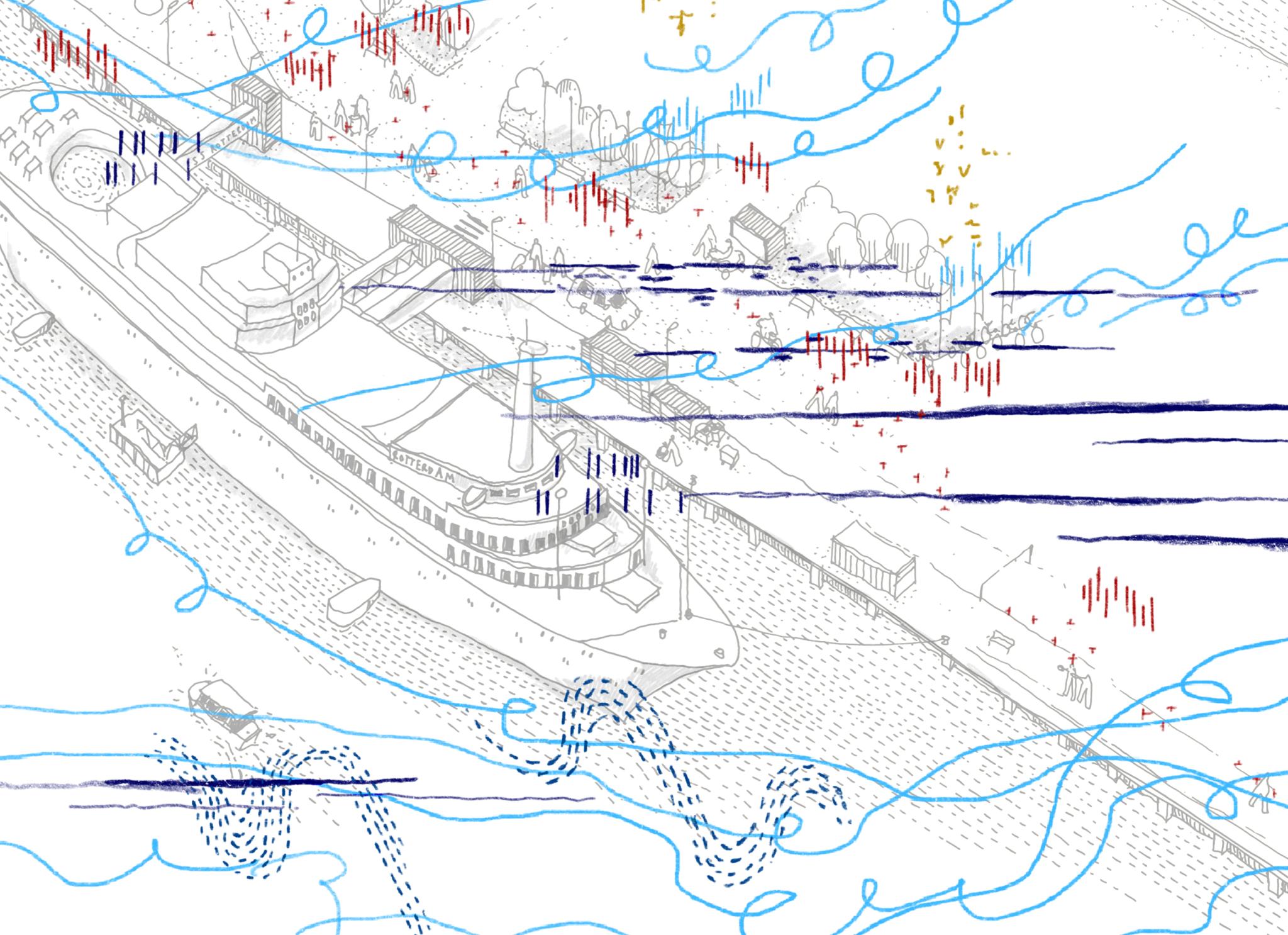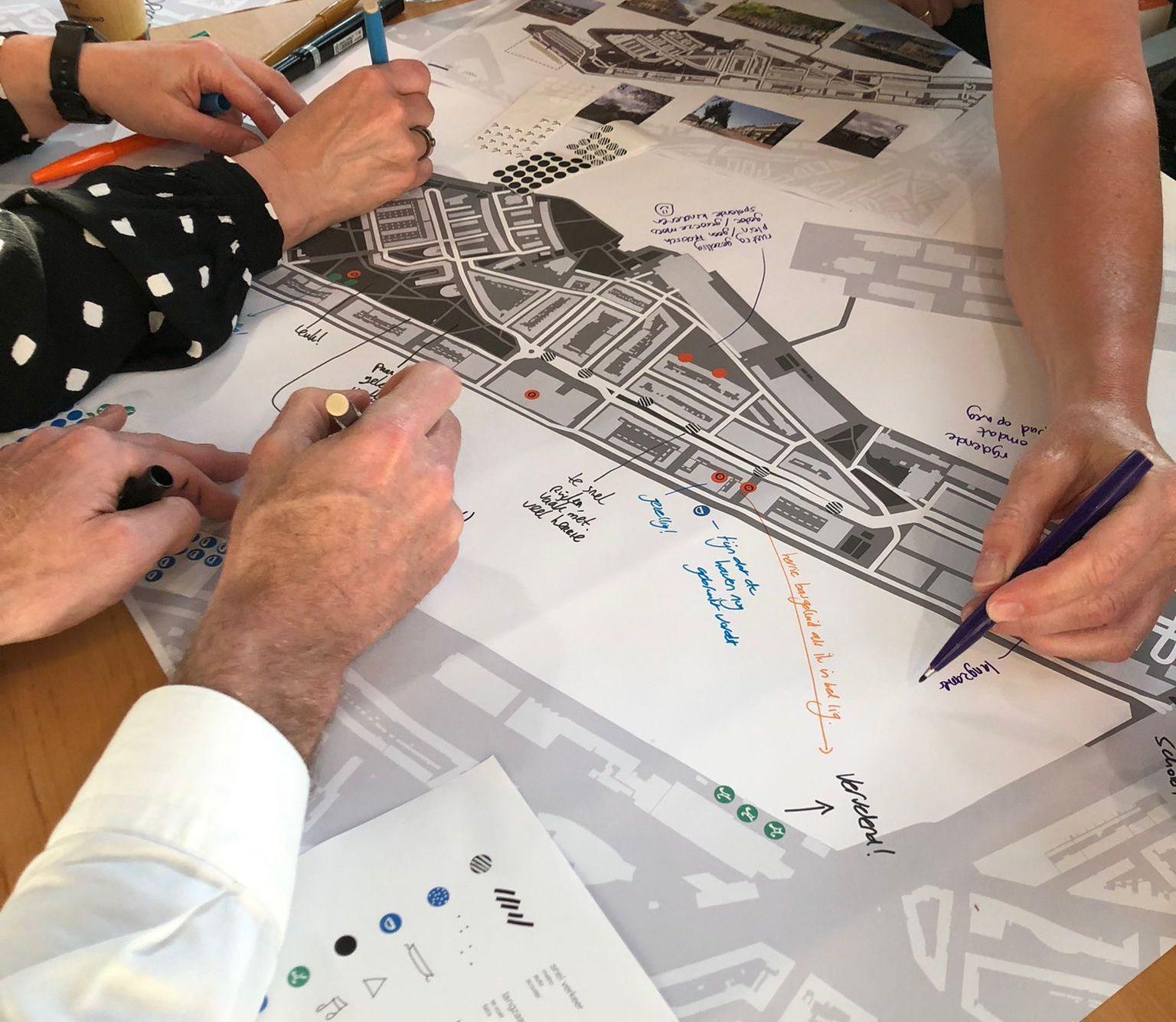Vincent Baptist, Sahar Asadollahi Asl Zarkhah, Rosa de Kruif
This article was originally published in Dutch on Gebiedsontwikkeling.nu

When you think of port cities, you think of industrial noise from passing ships and factories, right? An industrial peninsula like Katendrecht in Rotterdam South is nowadays no longer dominated by port labor and freight traffic, however. How is such a transformed harbor neighborhood perceived and experienced by residents in terms of noise nowadays? Urban developers could make good use of such insights.
How must it have been to live in Katendrecht 50 or 100 years ago? The peninsula in Rotterdam South, known for its role as a prostitution hub in the port city, was entirely in service of the port industry during the 20th century. Think of a long row of harbor sheds along Katendrecht’s southern Maashaven side, and impressive factory buildings on the northern Rijnhaven side. A few of the latter are still standing, but due to recent redevelopment plans, the last days of the industrial Codrico and Provimi complexes now also seem to be fast approaching.
Elsewhere in Katendrecht you can still find traces of the countless rails that used to run through the neighborhood to accommodate the continuous transport of goods flowing between ship and city. The most prominent streets in Katendrecht today - with the Brede Hilledijk in the lead - have clearly been redeveloped within the patterns of those former train tracks. The entrance to Katendrecht is demarcated by the Rijnhaven metro station and the Hillelaan, an important traffic artery that certainly puts pressure on the peninsula in terms of noise and noise pollution.
When reading Katendrecht’s previous redevelopment plans, all kinds of decibel regulations come into the picture: for example, the “noise load from the metro” at the time – about ten years ago – exceeded “the preferred values for housing and education” by more than 10 dB, and in the vicinity of industrial noise in Katendrecht uch buildings additionally had to be “realized by means of a so-called deaf facade”. All clear regulations, of course, which have been carefully developed on national and European levels, but do they also relate to how noise on the peninsula is actually experienced by residents?
Spatial experience
An earlier article on Gebiedsontwikkeling.nu already discussed how Katendrecht is the quintessential example of a modern gentrified neighborhood in Rotterdam. In this context, different groups of residents may have their own views on certain neighborhood facilities and features. Take for example the boats that still moor along the Maashaven side: their humming engine noise is quickly perceived as annoying by new residents living near that waterfront, but that is at the same time considered as quite inappropriate by long-term Katendrechters. If you do not want to hear any ship noises, then why would you even come and live in Katendrecht in the first place, no?
Sound thus forms a relevant angle through which to better understand new urban developments, and possibly also to gain a better grip on the broader social cohesion and resilience between different resident groups in a neighborhood. Research into the effects of noise on city residents and public health often focuses on individual experiences, such as sleep disturbances due to external noise sources. However, in a renovated harbor area like Katendrecht, public spaces are ideal places to broaden views and knowledge of sound experience, and thereby seek out further dialogue and nuances among different local residents. For example, it may well turn out that not everyone experiences the chatty buzz on the central Deliplein in the same way: conviviality for one person may well mean nuisance for another. This may allow residents to become more aware of sharing a neighborhood with each other, with people who have different experiences and views about their immediate living environment.
Mental maps
The sound recordings that we have recently collected cover all kinds of public spaces in Katendrecht - from the rust sculpture with benches on the Astanaplein to the picnic spot on the tip of Katendrecht's head - and are representative of the urban structure with different zoning profiles in which 21st-century Katendrecht has been classified.
Our sound measurements confirm obvious sound aspects, but also offer surprises. When stand near the Santos warehouse, the nearby car and metro traffic remains prominent both in the morning and evening. The sounds on the central Deliplein vary greatly, on the other hand, from a noisy evening with countless passers-by during the weekend to an almost silent scenery on a weekday evening. Researchers in the Swedish port city of Malmö previously wondered already: are gentrified neighborhoods not mainly characterized by silence?
To supplement sound measurements with individual insights from residents, we built on existing 'mental mapping' techniques. With colored markers and stickers in hand, we approached residents in public spaces and during neighborhood workshops to express their individual impressions about sound experience on maps of Katendrecht. Sound then no longer remains a theme that is difficult to capture, but an everyday factor about which everyone has some intuitive insights to share. For example, someone noted how traffic disruption in Katendrecht does not only occur on land and at sea: helicopters from the Erasmus MC often fly low over the high-rise buildings on the peninsula during their emergency flights. Long-term local residents, on the other hand, often indicated with a smile how they could enjoy the loud honking sounds with which the SS Rotterdam greets a passing ship.
The mental map drawings that local residents create individually or together in this way do not attempt to be representative reflections of sound experience across the entire neighborhood. The power of this material rather lies in uncovering 'micro-narratives' that can further explain the reality behind decibel numbers. The words that residents use are of extra importance in this respect: not everyone would use words such as 'loud' and 'quiet' to describe sonic situations in Katendrecht, but instead rather 'lively' or 'dead' to better express their personal experience of a public place.

Environmental stories
Urban developers and planners can benefit from knowing these words and stories of residents and taking them further into account, especially within a context such as that of the Dutch Environmental Act, where new environmental visions should be developed in a more participatory manner. The sound experience of a desolate Deliplein during a week evening can then for instance be used to advocate new neighborhood initiatives in Katendrecht. One of our interview respondents already noted that an annual Christmas market on the square would be a nice idea. As long as it does not violate the noise regulations for catering businesses, of course.
Acknowledgement
Vincent Baptist is Assistant Professor in the Architecture Department at TU Delft, Sahar Asadollahi Asl Zarkhah is PhD Candidate in the Urbanism Department at TU Delft, and Rosa de Kruif is recently graduated as Master student Urbanism at TU Delft. Together, they work on the Resilient Delta research project ‘NOISE®’, which focuses on public sound experiences in Katendrecht, Rotterdam. Collected data and results of the project will be presented at a free community event in Verhalenhuis Belvédère in Katendrecht on Friday 21 June, 17-20u.
This blog has been written in the context of discussions in the LDE PortCityFutures research community. It reflects the evolving thoughts of the author and expresses the discussions between researchers on the socio-economic, spatial and cultural questions surrounding port city relationships.
